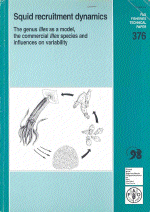Rodhouse, P.G.; Dawe, E.G.; O'Dor, R.K. (eds.)
Squid recruitment dynamics. The genus Illex as a model. The commercial Illex species. Influences on variability
FAO Fisheries Technical Paper. No. 376. Rome, FAO. 1998. 273p.
ABSTRACT
Squid are among the fastest-growing short-lived commercial species and, as opposed to most finfish resources worldwide, their contribution to the total world fish production has been increasing at a high rate in the two last decades. Also, since squids tend to have higher global market values than many fish, they have the potential to produce both larger and more valuable catches, given the same level of primary productivity. As annuals, ommastrephid squid, like those in the genus Illex used as an example in this volume, grow rapidly with high production to biomass ratios, but have no reserves of genetic diversity once a year class is overfished. Thus, detailed understanding of stock structure and highly variable recruitment dynamics is required to ensure conservation of the resource base and achieve sustainability of directed fisheries. Increment analysis for age and growth, and stomach content analysis, indicate flexible seasonality and feeding strategies allowing a wide range of habitats. I. coindetii occupies the Mediterranean, Caribbean and eastern Atlantic margin from 55°N to 20°S but never sustains major fisheries. In the western boundary currents of the Atlantic, I. illecebrosus collapsed after intense, widely distributed fishing in the north, while, in the south, I. argentinus has survived much longer as the world's largest squid fishery, possibly stabilized by a complex of stocks, with widely dispersed breeding in space and time. Selective gears in feeding areas may be self-limiting, so long as migration ensures adequate escapement and the squid are not pursued into breeding areas. Recruitment appears to be limited by food production and by instabilities in the interactions between adult migrations and ocean physics, which strongly influence early growth and survival. After chapters reviewing the principal commercial species of Illex, both techniques and results of studies on these influencing factors are reported in separate chapters by experts in their fields. |
